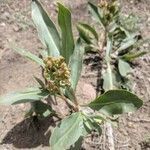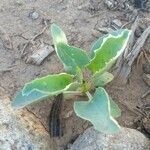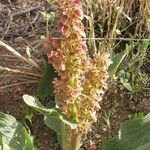Plants perennial, glabrous or indistinctly papillose-pubescent, with distinctly tuberous roots and short rhizomes. Stems usually erect, rarely ascending, branched above middle, 25-90(-100) cm. Leaves: ocrea prominent and persistent at maturity, whitish or silvery white, membranous; blade oblong, oblong-elliptic, or obovate-lanceolate, (5-)8-30 × 2-8(-12) cm, base cuneate or narrowly cuneate, margins entire, flat or indistinctly crisped, apex acute or acuminate, rarely obtuse. Inflorescences terminal, occupying distal 1/ 2 of stem, narrowly paniculate, rarely simple. Pedicels articulated near middle or in proximal 1/ 3, filiform, 5-15(-20) mm, articulation indistinct. Flowers 5-20 in whorls; inner tepals oblong-cordate or orbiculate-cordate, 11-16 × 9.5-14 mm, base sinuate or emarginate, margins entire, rarely with few extremely small denticles at base, apex obtuse or subacute; tubercles absent. Achenes brown or reddish brown, 4-5(-7) × 2.5-4.5(-5) mm. 2n = 40.
More
A small herb. It grows 90-100 cm high and spreads 50-70 cm wide. The tuberous roots are rich in tannin. It keeps growing from year to year. The leaves are spear head shaped and 30 cm long. They have slightly wavy edges. The flowers are on upright stalks. They changed from green to pink. The seeds are brown.



